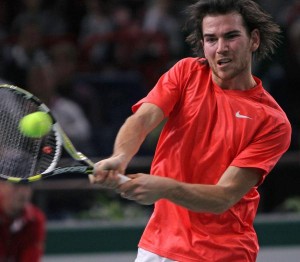Paris Masters 1000, Second Round
Precisely 52 weeks ago, the tone among spectators and players at the Paris Indoors was playful – alla scherzando – and the pulse of the tennis was a crisp vivace. The final Masters event of the year had laid down one of its fastest courts in years, and the indoor specialists were revelling in it. Confounding the fears of the mordant few, the slick surface had not produced a catastrophic return to the serve-centric yawn-fests of the 90s.  The tennis was ‘all-court’, which is more of the court than sees use for the bulk of the year: Robin Soderling’s aptitude for serve-volleying is commensurate with his capacity for light-hearted banter, and he still won the whole thing. Afterwards, Bercy 2010 was widely paraded as a rousing triumph – the semifinals were outstanding – and happy proof that fast indoor tennis can be something to savour, even in an era when almost no one can volley.
The tennis was ‘all-court’, which is more of the court than sees use for the bulk of the year: Robin Soderling’s aptitude for serve-volleying is commensurate with his capacity for light-hearted banter, and he still won the whole thing. Afterwards, Bercy 2010 was widely paraded as a rousing triumph – the semifinals were outstanding – and happy proof that fast indoor tennis can be something to savour, even in an era when almost no one can volley.
A year on, and the tone in Paris has soured, which would have been fine if the talk was empty, and if tone was all there was. Sadly, there’s been tennis, too, and it has mostly borne out the chatter. The new court is slow – although perhaps less glacial as has been stridently declared – and the balls are slower still, which has allowed Jo-Wilfried Tsonga to pick up his ranting where he left off in Valencia. (His inability to pass Sam Querrey was held up as a clear reflection of the conditions, and not as a reflection of his passing shots.)
The slowness of the Paris court doubtless accounts for the trouble Mardy Fish had in seeing off Florian Mayer. Fish ranks among the more attacking players on the tour, primarily since he cannot keep the ball in play for very long. A treacley surface is consequently the last thing he needs, especially with a Tour Finals berth at stake. Thus disadvantaged, he dropped three whole games, and let’s not forget that Mayer has been in rare form of late. Fish’s London spot is now but a single win away.
The thing is, even allowing for the court’s reduced speed, and for the tendency of the balls to fluff up quickly, it has made little tangible difference to the results. The upsets you might have expected on a fast court – Lopez defeating Monfils – have still happened. Players like Fish and Isner are looking strong. Federer looked lethal, while Murray and Djokovic are spry enough to cover any surface slower than oiled glass. As I write, Roddick has just self-destructed, demolished a racquet, and then abused Mohamed Lahyani for not issuing the code-violation fast enough. That has nothing to do with the surface, since unlike most players, whose tantrums require a reason, Roddick’s just need a place. More interestingly, not a single match in the second round went to a deciding set – is this some kind of record? – although I’m not convinced this says anything useful about the conditions, so much as the late-season form of some players. In any case, constant babble about the court speed is mostly a distraction, a specific extrusion of the sport’s essential echolalia; background noise swelling into the aural foreground, but never quite into music. The tennis goes on anyway.
